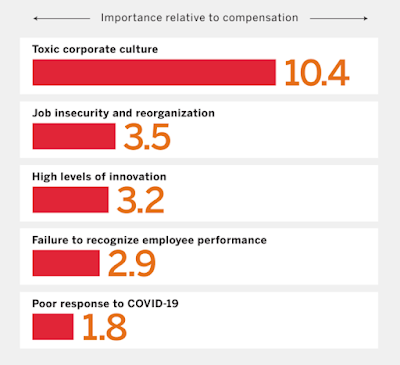Toxic culture and resignation: a correlation highlighted by MIT
January 2022
A study published by MIT on 500 companies and 34,000 employees reveals the causes of the “Great Resignation” taking place in the United States. Indeed, between April and September 2021, more than 24 million Americans left their jobs. This is an absolute record that is difficult to explain. This phenomenon does not have the brutality of the US in France, but it does exist and it is an important issue for companies.
The MIT study shows that there are very large differences between sectors of activity, with strong contrasts within the same sector – for example, in the financial sector, the resignation rate is 5.1% at HSBC while it is 15.2% at Goldman Sachs.
The study then shows that the major causes of departures are related to the company’s culture, much more than the remuneration factor.

Source : MIT study January 2022
The analysis of these causes of departure is not obvious.
A toxic culture
This is a broad concept, meaning that the collaborator feels that he or she cannot thrive in this company and sees that a majority of others feel the same way. A toxic culture is basically a culture that announces values and does the opposite in practice. It says “benevolence” but, in practice, it creates a climate of fear, it says “empowerment” but, in practice, it stigmatizes any risk-taking, etc.
Our WORLD expertise analyzes this well: when the World is out of tune between Grandeur, Recognition, Interaction and Decision, the Manager and the collaborator are lost. This dissonance, sometimes weak at the beginning, quickly becomes toxic over time. Changes in strategic direction, changes in the management team, mergers, etc. are all events that undermine the stability of a corporate culture, for better or for worse.
The other levers are in fact correlated to this first element, in the sense that they reveal more important dysfunctions
Job insecurity and reorganization
These two elements inevitably lead everyone to ask themselves if this is not the right time to move and see if the grass is not greener elsewhere. They are also signals that the company’s culture is going out the window. Reorganizations often only make the job more complex without providing real ways to do things differently. Do 3 in 5 years and you will lose your teams who no longer know where they live.
High level of innovation
This factor seems surprising, since innovation is so highly valued in companies. The explanation seems to lie in the pressure, the requirements and the workload that these highly innovative companies put on their collaborators. They wear out their collaborators at full speed, and since they have a good image, it is easy to find a less devouring follower.
Failure to recognize employee performance
This is a direct component of a World, and this point is directly related to the first one: a company with a failing recognition loop quickly becomes toxic for the performers who then go elsewhere.
Not taking the Covid into account
This seems to be a very US factor; in France, I have the impression that companies are exemplary. The study points out that the “Great Resignation” phenomenon developed simultaneously with the Covid pandemic. In the context of a health crisis, the inadequate management of managers (the absence of health policies and the failure to take into account the health of employees) was an important catalyst for resignations.
In summary, remember that if the WORLD, which organizes your company’s culture around the 4 pillars of Greatness, Recognition, Interaction and Decision, is well aligned with your business strategy and your teams’ expectations, then your attrition rate will be low within your business sector. If, on the other hand, your World is out of alignment then you will be in the high departure range. It is not a matter of providing an answer through speeches, pseudo barometers or “Employer Brand” communication. It’s about revisiting your WORLD with rigor and making it tangible through concrete evidence, on a daily basis, through simple but true gestures and actions.
Laurent Dugas
Want to know more ? contact us


